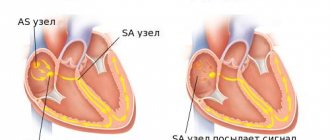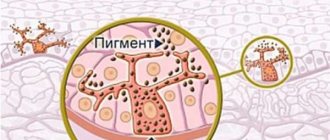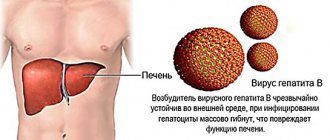Liver diseases are dangerous because they are quite difficult to identify and people do not immediately go to the clinic for diagnosis. This is due to the fact that the liver does not have nerve endings, just like our brain.
Painful sensations are already felt when the outer shell of the liver is irritated (it contains nerve endings), as well as neighboring organs that are negatively affected by the liver.
One of the most common diseases of this organ is hepatitis. There are many of its types and subtypes (genotypes), which have their own characteristics in treatment and prevention. Each of them has its own distribution in the world, as well as ways of infecting humans.
In this article we will dwell in detail on hepatitis C (C), its manifestations, symptoms, diagnosis and treatment. Let's look at who is more likely to become infected with the virus and how you can avoid it. At the end of the article you can find medications, their prices and analogues, which are often prescribed by doctors to treat the disease.
What is hepatitis C?
The cause of this disease is a virus that causes inflammatory liver disease. The danger for a person is that he may not even realize for years that he has hepatitis.
This is due to the fact that there may not even be symptoms, or they will appear similar to other diseases. In medical practice, this virus is called the “gentle killer”
thanks to the ability to camouflage.
History of origin
Various viruses have existed on earth for hundreds of centuries, most of them have not yet been identified. As for those that cause hepatitis, the following facts are known.
In the 70s of the last century, hepatitis and B viruses were precisely identified. At the same time, it was obvious that there were other types of the disease. Hepatitis C virus (HCV) was identified following the discovery of viral RNA that was similar to flaviviruses in 1989
.
Prevalence
It is safe to say that hepatitis C is widespread throughout the world. According to the World Health Organization (WHO), more than 150 million people
.
The disease is most common in Africa, as well as Central and East Asia. In Russia, Ukraine and Belarus, strains 1, 2 and 3 of hepatitis C are more common.
Who is susceptible to infection?
According to statistics, about 3-4 million people on Earth are infected with the virus in question every year. This most often occurs in young people.
Considering the routes through which infection enters the body, the following groups of people can be identified whose risk of infection is higher than others:
- drug addicts;
- prisoners;
- people who are directly involved in blood transfusion;
- workers of medical institutions;
- visitors to piercing and tattoo parlors;
- people who are promiscuous;
- family and close people of a person infected with hepatitis (if personal hygiene rules are not followed, contact with infected blood);
- HIV-infected.
According to various sources, more than 350 thousand people die annually from the consequences of the harmful effects of hepatitis C on the body and the onset of associated diseases.
Prognosis and consequences of viral hepatitis C
The course of the disease depends directly on the state of the immune system. Usually weakened immunity is observed
- in alcoholics,
- in patients with liver diseases,
- in older people and children who are often ill for a long time,
- in HIV-infected people.
With good immunity, the body copes with the virus, but in 30% of cases the disease gradually becomes a chronic process. When complications develop (cirrhosis and liver cancer), more than half of people die, sometimes at a young age. Specifically, no doctor can say for sure how long someone sick with viral hepatitis C will live; everything again depends on the body’s resistance, the age of the patient, his lifestyle and the form of the disease.
With cirrhosis of the liver, gradual degeneration of the liver tissue occurs, due to which the liver is not able to perform the functions of cleansing the blood of poisons and toxins. The body gradually begins to be poisoned by waste products.
Characteristic signs of cirrhosis are signs of intoxication, jaundice develops with the development of ascites (fluid accumulates in the abdominal cavity) and varicose veins of the esophagus and rectum. Varicose veins burst, and the bleeding that begins becomes fatal.
1% of people with hepatitis C develop a malignant tumor – liver cancer.
Forms
The virus can cause both acute and chronic hepatitis infection. The disease can last from several weeks until the very end of a person's life.
Acute form
the disease is considered safer.
It occurs without symptoms, but up to 45%
of patients get rid of the virus without even knowing about its presence.
This usually happens within 6 months
after infection.
In other patients, whose body has not developed immunity, transformation into a chronic form
hepatitis C. It is this that can cause serious health problems.
For example, 15-30%
of patients with this form of the disease
within 20 years
, which is a very dangerous disease.
Genotypes
Considering that the virus has an RNA chain, it is not surprising that there are many different genotypes (strains). To date, its ability to mutate has allowed it to develop into 11 genotypes
however, there are only
6
.
In terms of distribution, strains 1 and 3 are the most common - 46.2% and 30.1%
.
There are also different subtypes (subtypes) of a particular genotype. But, they are not given so much attention, since modern medications make it possible not to adjust the treatment regimen depending on the subtypes of the virus.
Genotypes and how they differ
The genome of the HCV virus has a complex structure, consisting of a main region (Core) and proteins (structural and non-structural). The role of the latter is to regulate the replication of the virus inside a human cell, ensuring the penetration of the pathogen through the membrane, etc.
However, the structure of HCV is not uniform. The terminal regions of some subspecies differ in the order of nucleotide joining (by approximately 30–35%). This difference gave rise to the creation of a generally accepted taxonomy and classification of HCV infection into genotypes.
Within one genotype, the nucleotide structure also differs, but not by more than 10–12%. Thus, genotypes are also divided into subtypes. The former are designated by Arabic numerals, the latter by Latin capital letters, for example, hepatitis C genotype 1b, 1a, 3a, etc.
Currently, more than 10 varieties of viral hepatitis C have been identified.
In accordance with the recommendations of WHO specialists, the generally accepted taxonomy of HCV infection is as follows:
| Genotype/halo distribution | Subtypes |
| First (1)/everywhere | a, b, c |
| Second (2)/everywhere | a, b, c, d |
| Third (3)/everywhere | a, b, c, d, e, f |
| Fourth (4)/Central Africa, Middle East | a, b, c, d, e, f, g, h, I, j |
| Fifth (5)/South Africa | a (little known) |
| Sixth (6)/Asia | a (little known) |
Table of distinctive features characteristic of different HCV genotypes
| Genotype | What is the difference |
| First | Long-term therapy lasting at least 12 months |
| Second | Short treatment period, no more than six months |
| Third | The course of therapy is 6 months. High risk of developing fatty degeneration of liver cells |
| Fourth | Difficult to respond to treatment. Individual selection of medications is required in each specific case |
| Fifth | Little studied |
| Sixth | Little studied |
In addition to differences in the structure of the virus, genotypes differ in the clinical picture (insignificant, as a rule, the disease occurs with hidden symptoms), and in the prognosis of development, and in methods of therapy. Thus, the most dangerous species common in Russia and the CIS countries is considered to be type 1b.
This pathology tends to quickly become chronic and is difficult to treat. Genotype 3a usually occurs acutely, but is more often accompanied by damage to the liver and cardiovascular system.
Transmission routes
The main mode of transmission is through contact with infected blood. At the same time, the viral load must be considerable so that when it enters the blood of a healthy person, the virus begins to infect the body.
Therefore, hepatitis C is most often transmitted among drug addicts, because they often use the same syringe without changing needles. Also, transmission of the virus can take place in tattoo or piercing parlors, where an infected person may have undergone a procedure before you, and after it the work equipment was not properly disinfected.
In underdeveloped countries, for the same reason, it is easy to become infected through a blood transfusion or dental treatment in a dental office.
There are other ways of transmitting hepatitis C:
- through hemodialysis;
- sexually;
- through work associated with constant contact with hepatitis patients;
- use of personal hygiene items by several people;
Infection of infants from mothers infected with hepatitis C occurs in less than 5% of cases.
In contrast to other types (for example, hepatitis B), this virus is practically not prone to sexual transmission, however, this type of infection is possible. The probability of infection in this way is from 3% to 5%
.
It is worth noting that the virus is not transmitted through breast milk, food, kissing, or drinking drinks from the same glasses with an infected person.
Interesting fact: if you are sick with hepatitis, you will be exempt from serving in the Russian army.
Is hepatitis C transmitted sexually?
For hepatitis C, sexual transmission is considered an unlikely route of transmission . If you had unprotected sexual contact with an infected partner, then the probability of infection is no more than 3-5%.
Using a condom reduces the risk of infection to zero. It is impossible to determine from a person’s appearance whether he has hepatitis C or not, much less whether he is infected or not.
The risk of transmitting hepatitis C through sexual contact increases with a large number of regular casual relationships without protection, as well as with aggressive sex with possible damage to the mucous membranes, their bleeding, anal sex without a condom or sexual intercourse during menstruation in a woman. If a person is married, then the risk of infection through sexual contact is minimal (1%).
Symptoms and diagnosis of the disease
In terms of manifestations, hepatitis C is a fairly “modest” disease. The incubation period lasts for 6 months
Moreover,
80%
of patients do not have any manifestations of the disease. But doctors still identify certain symptoms of hepatitis C.
Patients with the acute form may complain of:
- high temperature;
- nausea and loss of appetite;
- general fatigue;
- vomiting;
- pain in the abdomen and joints;
- gray stool;
- darkening of urine;
- jaundice.
Practice shows that due to the absence of symptoms, in most cases the disease can develop for decades before it is detected when a person undergoes diagnostics not directly related to hepatitis.
There are several stages in determining the presence of a virus:
- Serological test (screening) - a sensitive study for the presence of antibodies and antigens in the patient’s biological material (blood).
- RNA test by nucleic acid amplification method.
If a virus is detected, the patient is referred for a liver biopsy and other tests that can show the extent of liver damage. In addition, it may be necessary to undergo additional studies to establish the genotype of the virus in order to correctly choose the method of treating the disease.
Symptoms of the disease
Often, the symptoms of viral hepatitis C go undiagnosed for years and are only detected when the liver tissue is destroyed. Sometimes patients are first diagnosed with hepatitis C when they are already at the stage of cirrhosis.
The incubation period of the disease takes from one to three months. But, even after this period, the symptoms of the virus may not be pronounced. They are diagnosed with obvious liver damage.
Self-healing occurs in 10-15% of patients; in other cases, the development of primary chronic viral hepatitis C is observed. Rarely, such patients may have specific symptoms.
Symptoms of acute illness
Acute hepatitis C is accompanied by the following symptoms:
- Feeling of overwork, exhaustion.
- Fever (rare).
- Nausea and vomiting.
- Abdominal pain.
- Lack of appetite.
- Jaundice (rare).
- Dark urine and light feces.
- Joint pain.
- Skin itching and rashes.
This is interesting: Is it possible to become infected with hepatitis C at home?
Symptoms of a chronic disease
“The gentle killer” is the nickname given to hepatitis C due to the fact that at the chronic stage, the disease manifests itself sparingly. Therefore, both the patient himself and even an experienced doctor may not recognize the viral form of hepatitis in time. As a result, patients seek help for serious pathologies that doctors cannot fight.
Despite this, symptoms of chronic hepatitis C include:
- Excessive feeling of fatigue, especially after physical activity.
- Autonomic disorders.
- Feeling of heaviness and pain in the right side after eating.
- Weight loss for no apparent reason.
Patients often experience negative neurological phenomena:
- Poor sleep, insomnia.
- Apathetic state.
- Depression.
- Nervousness.
When liver dysfunction has reached the severe stage, the disease manifests itself much more noticeably:
- Bitterness in the mouth.
- Yellowish skin and mucous membranes.
- Edema of the lower extremities.
- Stomach upsets, “indigestion.”
- Vasodilation.
- Changing the shape of the fingers.
Possible mental disorders:
- Hallucinations.
- Fainting.
- Loss of coordination.
- Decreased brain activity, resulting in loss of mental abilities.
There is no gender division in the symptoms of viral hepatitis C. But, according to statistics, women suffer from the disease more easily than men. This is not connected at all with gender, but with the presence in the lives of men of factors that negatively affect the liver: alcohol, poor diet, etc.
Treatment
Not in all cases the body requires external treatment for this disease. There are common cases when the immune system gets rid of the virus on its own within 6 months from the moment of infection. In cases where a person's disease has developed into a chronic form, there may be no liver destruction.
If intervention is still required, medications are used.
.
Until recently, treatment was carried out using injections of ribavirin or interferon for 48 weeks
. This method showed not only its ineffectiveness, but also threatened with serious consequences for the human body.
Today, direct-acting antiviral drugs are used. In addition to the fact that the treatment is less painful, you can get rid of the virus after 12 weeks of therapy
. In developed countries the cost of such drugs is low, but in some poor countries their price is unaffordable.
An example of such a drug is Sofosbuvir
or other medicines containing the active substance of the same name in combination with other ingredients:
- Heterosovir Plus;
- Viropak;
- Sofolanork;
- Augispov
- Sofolanorc Plus and others.
The cost of these drugs is in the same price range - 10-11 thousand rubles
(from 4400 to 5000 hryvnia).
Do you need a diet?
Given the harmful effects of the virus on the liver, it is recommended to adhere to a special diet and the following tips:
exclude
fatty fish, smoked meats, marinades, pickles, synthetic additives, cooking fats, meat and fish broths, spicy dishes, any other fried and fatty foods, pork, lamb, duck, cocoa, mushrooms, sorrel, chocolate, ice cream, low and high temperature drinks ;
can be consumed
vegetable, milk and fruit soups, borscht, chicken, lean fish, beef and veal, cereals, pumpkin, boiled onions, olive, vegetable, butter, cottage cheese, kefir, alcoholic drinks and other products.
Let us add that the Soviet nutritionist Mikhail Pevzner developed a diet, which he called No. 5, to help people with diseases of the liver, biliary tract and gall bladder. Experts recommend sticking to it even if you are infected with the hepatitis C virus.
If infection occurs, is it possible not to get hepatitis C?
- With a very strong immune system, after infection a person suffers from hepatitis C in a mild form and recovers. The frequency of such cases approaches 20%.
- In most cases - 70%, after infection, a person acquires chronic hepatitis C. Therefore, all carriers of the virus, without exception, should be regularly examined and observed by a doctor, since the risk of virus activation remains in all carriers for the rest of their lives.
- You can also become infected and remain a carrier of the virus. At the same time, hepatitis C multiplies very slowly, without showing any symptoms. Neither liver tests nor liver biopsy are abnormal and no changes are observed. However, this does not exclude the progression of the virus in a latent form.
Prevention
To date, a vaccine has not yet been invented that would guarantee a 100% result in developing immunity to the hepatitis C virus. However, doctors recommend following the following rules to reduce the likelihood of infection by 75%
:
- observe the rules of personal hygiene;
- use only disinfected medical equipment or new ones, where possible (syringes, games, etc.);
- do not visit questionable piercing or tattoo parlors;
- do not visit places where there is unsanitary conditions;
- use condoms during sexual intercourse;
- Avoid contact with other people's blood.
Diagnostics
Diagnosis of hepatitis C is currently not difficult and begins with collecting anamnesis, identifying possible contacts with the source of infection, and determining the extent of previously performed invasive medical interventions. Next, the doctor conducts a visual examination of the skin and palpates the abdominal cavity.
Instrumental and laboratory techniques make it possible to determine the degree of advanced disease in just a few days. The most common diagnostic techniques exclude erroneous diagnosis, as they provide the most accurate indicators.
Liver puncture biopsy . An invasive operation that provides maximum diagnostic benefit. A special instrument is used to pierce the abdominal cavity, reach the liver, from where a piece of liver tissue is “plucked off”. The resulting biopsy is examined to determine the degree of destruction of hepatocytes, the presence of an oncological process, etc. The manipulation is invasive and is carried out under the control of ultrasound equipment.
Ultrasound of the abdominal organs . An informative method for visualizing the liver, pancreas, and spleen. Allows you to identify the degree of fibrosis, the presence of ascitic fluid and damage to other target organs suffering from the pathogenic effect of the virus.
Fiber scanning (elastometry) . The modern non-invasive equivalent of a biopsy. Carry out on the Fibroscan device. The purpose of the study is to obtain a complete picture of the condition of the liver as a whole, and not just one or several of its fragments.
CT, MRI . High-precision methods for visualizing internal organs and assessing their condition. They will help in diagnosis, in assessing the success of therapy, and in the early detection of severe complications of an infectious disease.
Self-diagnosis . If there was a questionable contact, enzyme-linked immunosorbent test systems will help to detect antibodies to the hepatitis C virus (Anti-HCV, ELISA-anti-HCV DIAplus, etc.). Such products are sold without a prescription in almost every pharmacy, are inexpensive, and easy to use. Detailed instructions included with each package will help you carry out a preliminary analysis on your own. The sensitivity of the tests is approximately 96%.
How to get tested for hepatitis C in a clinic? At a consultation appointment, the doctor gives a referral to a general clinical laboratory, where they do a hemogram, a blood test for biochemistry (biomaterial is taken strictly on an empty stomach), a test for the presence of hcv antibodies, etc.
PCR analysis
RNA determination is carried out by polymerase chain reaction, which can be performed using several methods:
- Reverse transcription (RT-PCR or RT-PCR) . It is done by enzymatic production of the required number of copies of specific fragments of complementary DNA with a preceding stage of reverse transcription. The method has been used since 1990. The enzyme used is DNA-dependent DNA polymerase from the bacteria Thermophilus termus. Detection is carried out in real time, which eliminates microbial contamination and increases specificity and sensitivity. Data is recorded automatically, which eliminates incorrect interpretation of PCR analysis results.
- “Nested” PCR is one of the subtypes of RT-polymerase chain reaction . Performed in some laboratories to improve sensitivity and specificity. It differs from the classical one in the use of two pairs of primers.
- Ligase reaction for RNA detection (LR) . The analysis is based on the property of DNA-dependent DNA ligase to ligate (“crosslink”) phosphodiester bond breaks in DNA under the influence of ATP and Mg2+.
- Transcription-mediated amplification (TMA) . The technique involves a complex mechanism of interaction between RNA and complementary DNA. The advantage of this method is the speed of execution (up to 40 minutes) and high sensitivity (up to 50 copies/ml).
- Hybridization using branched probes . Currently, analysis is practically not carried out due to low sensitivity.
The total result is presented in table form, for example:
| Qualitative PCR | |
| HCV not detected | Norm |
| HCV detected | Further research needed |
| Quantitative PCR | |
| 600–3ˑ105 IU/ml | Low viral load |
| 3ˑ105–8ˑ105 IU/ml | Average viral load |
| More than 8ˑ105 IU/ml | High viral load |
Experts recommend conducting tests in stages. First, high-quality PCR, which shows whether the hepatitis C pathogen is in the body. If the result is positive, a quantitative test is performed, demonstrating the intensity of infection, then genotyping of the hepatitis C virus. How many days the analysis is done depends on the specific laboratory. On average, this period is 2–6 days.
Genotyping is intended to determine the exact type of hepatitis C virus. This is necessary to prescribe appropriate therapy and predict the possible development of the disease. The study is also carried out using the PCR method, the analysis is repeated only once.
False suspicion
False suspicion of HCV may arise due to incorrect interpretation of ELISA results. In a third of cases, the pathology occurs in an acute form, and with an adequate immune response it is suppressed and does not become chronic.
However, the penetration of the virus into the body provokes the production of antibodies (AB), which are detected by ELISA. Therefore, if the test result is positive, it is necessary to conduct PCR (if necessary, several tests at intervals of 2-3 weeks), confirming or refuting the alleged diagnosis.
How long does it take for it to appear after infection?
The minimum period when it is possible to identify pathological markers (HCV RNA) in a laboratory is 10–14 days. If a person suspects the possibility of infection, and the test result is negative, it should be repeated a week later. It is advisable to carry out high-quality PCR.
Clinical symptoms of the disease may not appear for a long time, even if the virus is actively multiplying in the liver. But 1–3 months after infection, weakness, increased fatigue, and spontaneous low-grade fever sometimes occur.
Forecast
If a person is diagnosed with hepatitis C, this is not a fatal diagnosis. If the disease has become chronic, it may not develop for decades or have a negligible harmful effect on the liver.
In any case, in order to prevent infection or increase the harmful effects of the virus introduced into the body, you should lead a healthy lifestyle, give up alcohol and harmful foods.
If necessary, you need to use concomitant medications prescribed by your doctor.
Is hepatitis C transmitted through household contact or airborne transmission?
Hepatitis C is definitely not transmitted by airborne droplets, neither by talking, nor by coughing or sneezing. Also, neither handshakes, nor hugs, nor shared kitchen utensils, shared food or drinks contribute to the spread of the virus, and hepatitis C is not transmitted through insect bites.
Only in the event of an injury, abrasion, or in everyday life can the virus be transmitted from a carrier to a healthy person through blood particles, but the likelihood of this is negligible. The presence of infection should not be a reason to isolate this family member and create special conditions for him. You just have to be careful if someone carrying the virus has bleeding wounds. Young people who are carriers of the virus in Russia are exempt from serving in the country's army.
The first signs during the acute period
Initial signs in men and women are most often absent. Even the acute form of hepatitis C can reveal itself only by the presence of weakness, rapid fatigue, joint pain, and an infectious respiratory disease. The emerging symptoms of jaundice, or the icteric form, are not always found. This cannot be said to be a plus, since diagnosis at the stage after the incubation period provides quick and effective treatment, and skipping patience at this stage leads to the pathology becoming chronic.
To summarize, the first signs and symptoms are a rare occurrence; if they occur, they are usually similar to a cold or ordinary temporary weakness.
How much does treatment cost?
Costs for modern medications needed for treatment can range from $550 to $2,500 per month. The duration of treatment is 12 months (respectively, $6600-30000 per year).
Newer, effective, studied, easy-to-use drugs produced by well-known companies are more expensive - 40-100 thousand dollars for a course of therapy.
The main costs are for interferon drugs. Foreign-made pegylated interferons are more expensive than conventional interferons from any manufacturer.
How to treat?
In the treatment of chronic hepatitis C there is no single standard of treatment; each case is purely individual. Complex treatment is prescribed after a thorough analysis of the following factors:
- Degree of liver damage;
- Probability of success;
- The patient's readiness to begin therapy;
- The presence of concomitant diseases;
- Potential risks of adverse events.
The most effective treatment for viral hepatitis C today includes complex antiviral therapy with ribavirin and interferon. These drugs are general genotypic, that is, they are effective against all genotypes of the virus.
The difficulty with treatment is that some patients do not tolerate interferon well, and the drug is not widely available. The cost of treatment for hepatitis C is not affordable for everyone, so many patients simply do not complete treatment and the virus develops resistance to the drugs they are taking. If the patient subsequently starts a new course of therapy with resistance to antiviral drugs, there will be no effect from the treatment.
People are more likely to show positive signs of response to hepatitis C combination therapy:
- European race;
- Female;
- Weight less than 75 kg;
- Age under 40 years;
- Low insulin resistance;
- No signs of severe liver cirrhosis.
Most doctors use a combined treatment regimen for hepatitis, the so-called dual therapy - a combination of interferon, which actively fights the virus, and ribavirin, which enhances the effect of interferon.
The patient is administered short-acting interferon daily or once every three days, and long-acting interferon (pegylated interferon) in combination with ribavirin (used daily in tablet form) once a week. Depending on the type of virus, the course is 24 or 48 weeks. Genotypes 2 and 3 respond best to therapy - treatment success is 80-90%.
For genotype 1, combination therapy is successful in 50% of cases. If the patient has contraindications to combination therapy, interferon-alpha monotherapy is prescribed. In this case, the course of therapy lasts 12-18 months. Long-term monotherapy with interferon-alpha reduces the viral load in 30-50% of cases.
New drugs for treatment
As of November 2020, next-generation therapeutic regimens consisting of two or three replication inhibitors sofosbuvir/velpatasvir/voxilaprevir from Gilead and glezaprevir/pibrentasvir ± sofosbuvir, tested by AbbVie, are undergoing the final phase III of clinical trials. Both regimens demonstrate high pangenotypic activity and efficacy in multidrug-resistant individuals.
The first pangenotypic representatives of the class of non-nucleoside inhibitors of NS5B polymerase CC-31244 and the injectable form of a prolonged action GSK2878175 are undergoing phase I-II clinical trials. Both inhibitors can potentially be used in combination therapy with both other classes of DAAs and indirect-acting antiviral drugs.
How long do virus carriers live?
After about 15-30 years, chronic pathology leads to severe, irreversible damage to the organ - cirrhosis of the liver. Due to the fact that the risk group consists mainly of young people under 30 years of age, the risk of catastrophic consequences at 45-60 years of age, and perhaps even earlier, is relevant. This is the outcome that awaits about 20% of patients with chronic hepatitis C.
In addition, a person with a damaged liver suffers from a deterioration in their quality of life. One of its main functions is reduced - the neutralization of metabolites after drinking alcohol and fatty foods. Blood stagnation cannot be ruled out, which may occur due to deterioration of the filtration capabilities of the liver.
Premature death of a patient diagnosed with hepatitis C is likely, caused by indirect causes. For example, due to deterioration of the liver, other serious defects may develop in the body.
The final stage of hepatitis C - cirrhosis of the liver - manifests itself in the form of a total disruption of the organ, emptying of small vessels and the formation of large blood flows. This process is irreversible, and it is almost impossible to eliminate it even with the help of modern techniques.
Due to compaction of the parenchyma, congestion appears in the abdominal cavity. Against the background of this process, the walls of the arteries expand, which is fraught with rupture of blood vessels and severe bleeding. Sometimes patients with this diagnosis develop cancer of the damaged organ.
Risk group for hepatitis C - who should be especially careful?
a high risk of infection:
- In people who received blood transfusions before 1987, as well as all people who had surgery before 1992.
- Health care workers who have daily contact with people infected with hepatitis C.
- In people who use injection drugs.
- HIV-infected people (see symptoms of HIV infection, AIDS dissidents)
Moderately increased risk of hepatitis C infection:
- People with various undiagnosed liver diseases
- Patients on hemodialysis
- Children born to infected mothers are always at risk of accidentally becoming infected from their mother.
Low risk of infection:
- All medical workers
- Employees of sanitary and epidemiological services
- People who are sexually active, have many casual partners and do not use condoms.
- People with one but infected partner
There is a family member with hepatitis C - what to do?
Considering how hepatitis C is transmitted and that it survives in the external environment for up to 96 hours, if by chance the blood of an infected family member gets somewhere in the room, on clothing, etc., the surface should be treated with any chlorine-containing products - Domestos, Whiteness, Chlorhexidine (for skin). When washing clothes or linen at 60C, the virus dies in half an hour, and when boiled, in two minutes.
The virus carrier himself must follow basic measures to prevent transmission of the infection to his loved ones:
- For any injuries, abrasions and bleeding, you should urgently bandage the injury sites or cover them with a plaster. When assisting an infected family member, gloves should be worn.
- Have only personal manicure sets, razors, epilators, toothbrushes, and never use those household items that are used by other family members and which may be potential factors for transmitting the virus.
Author:
Selezneva Valentina Anatolyevna physician-therapist
Signs of the disease
The main feature of hepatitis C is the absence or short-term jaundice of the skin. This shade of the cornea and integument is a symptom of liver damage, or more precisely, a sign of an increase in the volume of bile pigment in the bloodstream. Bilirubin is the name of this pigment; it can penetrate into the blood due to various pathologies of the bile ducts or liver parenchyma.
The first signs of hepatitis C:
- general fatigue, weakness and severe apathy;
- decreased ability to work;
- loss of appetite;
- pain in the right hypochondrium, which indicates inflammation or dyskinesia in the gallbladder;
- an increase in the size of the liver, which is felt upon palpation - this symptom can only be identified by a doctor, but the patient himself can only feel distension in the area of the organ;
- Persistent fever cannot be ruled out.
Among other things, the patient may experience symptoms that have nothing to do with the liver. This is another feature of hepatitis C.
Here are the main signs not related to liver function:
- damage to the myocardium and joints;
- various vision problems;
- rashes from papules on mucous membranes and skin;
- damage to the bladder and kidneys.
None of these symptoms are specific, but almost always indicate damage to the liver and other organs that interact with it.
Other signs of the virus can be detected through instrumental and laboratory tests.











